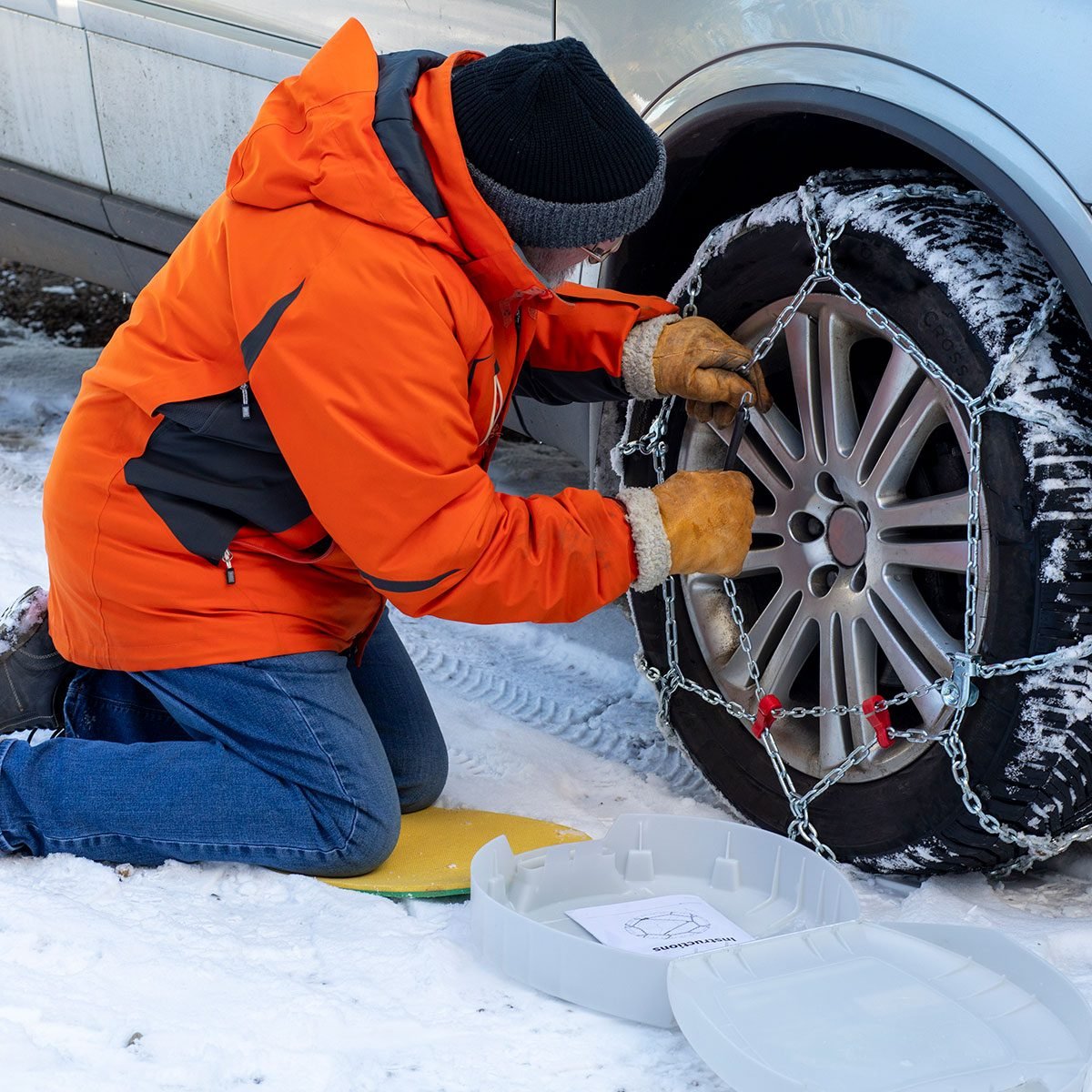How to Put on Snow Tires
To put on snow tires, first, lift the vehicle, then remove the current tires and install the snow tires. As winter approaches, it is essential to ensure your vehicle is equipped with the proper tires to navigate snowy and icy conditions safely.
Switching to snow tires can significantly improve traction and handling on winter roads, reducing the risk of accidents. By following a few simple steps, you can quickly and effectively put on snow tires to enhance your vehicle’s performance in challenging winter weather.
In this guide, we will provide you with step-by-step instructions on how to properly install snow tires on your car, ensuring you are prepared for safe and secure winter driving.

Credit: www.familyhandyman.com
Choosing The Right Snow Tires
When it comes to driving in snowy and icy conditions, having the right tires is essential for safety and performance. Choosing the right snow tires can make a significant difference in your winter driving experience, providing better traction and handling on slippery roads.
Snow Tire Types
Snow tires, also known as winter tires, come in various types designed for specific driving conditions. These include:
- Studded tires – fitted with metal studs for exceptional grip on ice.
- Performance winter tires – optimized for enhanced handling and traction in cold, dry conditions.
- Studless ice and snow tires – designed with advanced rubber compounds for improved traction on ice and snow.
Tire Size And Compatibility
Ensuring the right size and compatibility of snow tires is crucial for optimal performance. Consult your vehicle’s manual or a tire professional to determine the correct tire size based on the make and model of your vehicle. Ensuring compatibility with your vehicle’s wheel size and load-bearing capacity is essential for safe and effective use of snow tires.
Preparing Your Vehicle
When preparing your vehicle for snow tire installation, it is crucial to inspect your tires and wheels, check tire pressure, and gather necessary tools to ensure a safe and effective process.
Inspecting Tires And Wheels
- Check for any visible damage or wear on the tires.
- Inspect the wheels to ensure they are free of rust or corrosion.
- Look for any foreign objects lodged in the treads.
Checking Tire Pressure
- Use a tire pressure gauge to measure the pressure in each tire.
- Ensure the pressure matches the manufacturer’s recommendations.
- Inflate or deflate the tires as needed to reach the correct pressure.
Gathering Necessary Tools
Before starting the snow tire installation process, gather the following tools:
| Tools | Function |
|---|---|
| Lug wrench | For loosening and tightening lug nuts |
| Jack | To lift the vehicle off the ground |
| Tire pressure gauge | To check and adjust tire pressure |
| Tire iron | For removing and installing lug nuts |
Removing Regular Tires
Before putting on snow tires, you need to safely remove the existing regular tires. This process involves lifting the vehicle, removing the lug nuts, and then taking off the tires.
Lifting The Vehicle Safely
- Place a jack under the appropriate lifting point of the vehicle.
- Jack up the vehicle until there is enough space to work comfortably.
Removing Lug Nuts
- Loosen the lug nuts using a lug wrench before completely removing them.
- Place the lug nuts in a secure location to prevent misplacement.
Taking Off The Tires
After removing the lug nuts, carefully take off each tire by gripping it firmly and pulling it straight towards you.

Credit: www.bridgestonetire.com
Mounting Snow Tires
When the snow and ice arrive, mounting snow tires is essential to ensure safe and secure driving. Follow these simple steps to mount your snow tires properly.
Aligning The Rim
Before mounting the snow tire, make sure the rim is clean and free from any debris or moisture. Properly align the rim with the tire to ensure a seamless fit. Carefully examine the rim to ensure it is in good condition, free from any dents or damage. Aligning the rim is crucial for a successful installation.
Mounting The Snow Tire
Using a hydraulic jack, elevate the vehicle to remove the existing tire. Carefully position the snow tire onto the rim, ensuring it is properly centered. Gently press down on the tire to secure it in place. Mounting the snow tire with precision is vital for optimal performance on snowy roads.
Securing With Lug Nuts
Once the snow tire is in position, secure it using the appropriate size and type of lug nuts. Tighten the lug nuts in a crisscross pattern to ensure even distribution of pressure. Be sure to fasten the lug nuts securely to prevent any wobbling or imbalance. Properly securing with lug nuts is crucial for safe driving in snowy conditions.
Balancing And Inflating Snow Tires
Snow tires are an essential requirement for safe winter driving. However, simply installing snow tires on your vehicle is not enough to ensure optimal performance. It is crucial to balance and inflate the tires correctly to maximize their effectiveness on icy and snowy roads. In this section, we will discuss the importance of balancing and inflating snow tires, and provide step-by-step instructions on how to accomplish these tasks.
Balancing The Tires
Balancing the snow tires is essential to prevent vibrations and uneven tire wear. The process involves equalizing the weight distribution of the tires to ensure smooth and stable performance. It is recommended to have the tires balanced by a professional at a reputable auto shop. However, if you prefer to do it yourself, follow these steps:
- Securely jack up the vehicle and remove the tires one by one.
- Inspect the tires for any signs of damage or uneven wear.
- Attach the wheel to a portable balancer or a static balancer.
- Rotate the wheel and observe if it comes to a rest in a level position.
- If the wheel is unbalanced, use adhesive wheel weights to add weight to the lighter side until it is balanced.
- Repeat the process for all the snow tires.
- Once the tires are balanced, remount them on the vehicle and secure them properly.
Inflating The Tires To The Recommended Psi
Inflating snow tires to the recommended tire pressure is vital for optimal traction and handling. Underinflated tires can reduce grip on snowy surfaces, while overinflated tires may result in reduced contact patch, affecting stability and handling. Follow these steps to inflate snow tires to the recommended PSI:
- Refer to the vehicle’s owner’s manual or the tire placard on the driver’s side door jamb to determine the recommended tire pressure.
- Remove the valve cap from each tire.
- Attach a tire pressure gauge to the valve stem and press firmly to get an accurate reading.
- If the reading is below the recommended PSI, add air using a tire inflator until the desired pressure is reached.
- If the reading is above the recommended PSI, release air using the valve core tool until the desired pressure is achieved.
- Repeat these steps for all the snow tires.
- Finally, replace the valve caps and ensure they are tightened securely.

Credit: www.wikihow.com
Frequently Asked Questions Of How To Put On Snow Tires
Which Way Do Snow Tires Go On?
Snow tires should be installed with the deeper tread facing outward for better traction. The tread pattern should be facing forward, helping to push snow away from the tire. This ensures optimal grip and safety on snow-covered roads.
Do You Put Snow Tires On All 4 Tires?
Yes, it is recommended to put snow tires on all four tires for balanced traction and handling in winter conditions.
How Hard Is It To Change Winter Tires?
Changing winter tires is a straightforward process that requires basic tools and some effort. It can be done at home or by a professional.
Do You Put Snow Chains On All 4 Wheels?
Yes, it is recommended to put snow chains on all 4 wheels for optimal traction and stability in snowy conditions.
How Long Do Snow Tires Last?
Snow tires usually last for about 4 to 6 seasons, depending on how frequently and harshly they are used.
What Is The Best Time To Put On Snow Tires?
It is recommended to put on snow tires when temperatures consistently drop below 45°F (7°C) to ensure maximum traction.
Can I Put Snow Tires On Just The Front Wheels?
While it is possible to put snow tires on just the front wheels, it is highly recommended to install them on all four wheels for better stability and control.
Conclusion
Properly installing snow tires is essential for driving safety in wintery conditions. By following the step-by-step guide outlined in this blog post, you can ensure that your vehicle is equipped to handle snow and ice. Don’t forget to check tire pressure regularly to optimize performance.
Stay safe on the roads!


